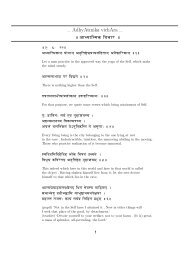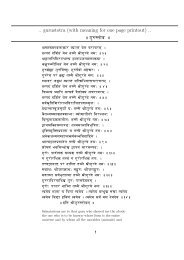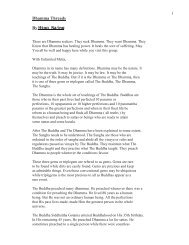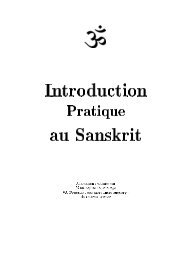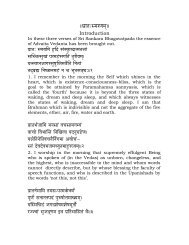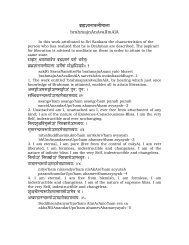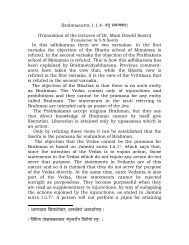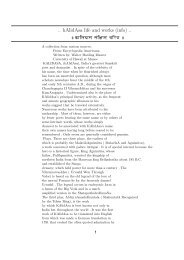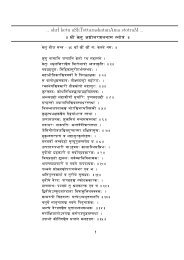HINDU RITUALS AND ROUTINES - Sanskrit Documents
HINDU RITUALS AND ROUTINES - Sanskrit Documents
HINDU RITUALS AND ROUTINES - Sanskrit Documents
Create successful ePaper yourself
Turn your PDF publications into a flip-book with our unique Google optimized e-Paper software.
<strong>HINDU</strong> <strong>RITUALS</strong> <strong>AND</strong> <strong>ROUTINES</strong> - WHY DO WE FOLLOW THOSE?<br />
Contents<br />
1. Why do we light a lamp?............................................................................................................................ 2<br />
2. Why do we have a prayer room? ................................................................................................................ 3<br />
3. Why do we do Namaste?............................................................................................................................ 4<br />
4. Why do we prostrate before parents and elders? ........................................................................................ 5<br />
5. Why do we wear marks (tilak, pottu and the like) on the forehead? .......................................................... 6<br />
6. Why do we not touch papers, books and people with the feet?.................................................................. 7<br />
7. To touch another with the feet is considered an act of misdemeanor. Why is this so?............................... 7<br />
8. Why do we apply the holy ash?.................................................................................................................. 8<br />
9. Why do offer food to the Lord before eating it?......................................................................................... 9<br />
10. Why do we fast? ..................................................................................................................................... 10<br />
11. Why do we do pradakshina (circumambulate)? ..................................................................................... 11<br />
12. Why is pradakshina done only in a clockwise manner?......................................................................... 11<br />
13. Why do we regard trees and plants as sacred?........................................................................................ 11<br />
14. Why do we ring the bell in a temple? ..................................................................................................... 12<br />
15. Why do we worship the kalasha?........................................................................................................... 13<br />
16. Why do we consider the lotus as special? .............................................................................................. 14<br />
17. Why do we worship tulasi? .................................................................................................................... 15<br />
18. Why do we blow the conch?................................................................................................................... 16<br />
19. Why do we say shaanti thrice?............................................................................................................... 17<br />
20. Why do we offer a coconut?................................................................................................................... 18<br />
21. Why do we chant Om? ........................................................................................................................... 19<br />
22. Why do we do aarati? ............................................................................................................................ 20
1. Why do we light a lamp?<br />
In almost every Indian home a lamp is lit daily before the altar of the Lord. In<br />
some houses it is lit at dawn, in some, twice a day – at dawn and dusk – and in a few it is<br />
maintained continuously (Akhanda Deepa). All auspicious functions commence with the<br />
lighting of the lamp, which is often maintained right through the occasion.<br />
Light symbolizes knowledge, and darkness, ignorance. The Lord is the<br />
"Knowledge Principle" (Chaitanya) who is the source, the enlivener and the illuminator<br />
of all knowledge. Hence light is worshiped as the Lord himself.<br />
Knowledge removes ignorance just as light removes darkness. Also knowledge is<br />
a lasting inner wealth by which all outer achievement can be accomplished. Hence we<br />
light the lamp to bow down to knowledge as the greatest of all forms of wealth.<br />
Why not light a bulb or tube light? That too would remove darkness. But the<br />
traditional oil lamp has a further spiritual significance. The oil or ghee in the lamp<br />
symbolizes our vaasanas or negative tendencies and the wick, the ego. When lit by<br />
spiritual knowledge, the vaasanas get slowly exhausted and the ego too finally perishes.<br />
The flame of a lamp always burns upwards. Similarly we should acquire such knowledge<br />
as to take us towards higher ideals.<br />
Whilst lighting the lamp we thus pray:<br />
Deepajyothi parabrahma<br />
Deepa sarva tamopahaha<br />
Deepena saadhyate saram<br />
Sandhyaa deepo namostute<br />
I prostrate to the dawn/dusk lamp; whose light is the Knowledge Principle (the<br />
Supreme Lord), which removes the darkness of ignorance and by which all can be<br />
achieved in life.
2. Why do we have a prayer room?<br />
Most Indian homes have a prayer room or altar. A lamp is lit and the Lord<br />
worshipped each day. Other spiritual practices like japa (repetition of the Lord’s name),<br />
meditation, paaraayana (reading of the scriptures), prayers, and devotional singing etc is<br />
also done here. Special worship is done on auspicious occasions like birthdays,<br />
anniversaries, festivals and the like. Each member of the family - young or old -<br />
communes with and worships the Divine here.<br />
The Lord is the entire creation. He is therefore the true owner of the house we live<br />
in too. The prayer room is the Master room of the house. We are the earthly occupants of<br />
His property. This notion rids us of false pride and possessiveness.<br />
The ideal attitude to take is to regard the Lord as the true owner of our homes and<br />
us as caretakers of His home. But if that is rather difficult, we could at least think of Him<br />
as a very welcome guest. Just as we would house an important guest in the best comfort,<br />
so too we felicitate the Lord’s presence in our homes by having a prayer room or altar,<br />
which is, at all times, kept clean and well-decorated.<br />
Also the Lord is all pervading. To remind us that He resides in our homes with us,<br />
we have prayer rooms. Without the grace of the Lord, no task can be successfully or<br />
easily accomplished. We invoke His grace by communing with Him in the prayer room<br />
each day and on special occasions.<br />
Each room in a house is dedicated to a specific function like the bedroom for<br />
resting, the drawing room to receive guests, the kitchen for cooking etc. The furniture,<br />
decor and the atmosphere of each room are made conducive to the purpose it serves. So<br />
too for the purpose of meditation, worship and prayer, we should have a conducive<br />
atmosphere - hence the need for a prayer room.<br />
Sacred thoughts and sound vibrations pervade the place and influence the minds<br />
of those who spend time there. Spiritual thoughts and vibrations accumulated through<br />
regular meditation, worship and chanting done there pervade the prayer room. Even when<br />
we are tired or agitated, by just sitting in the prayer room for a while, we feel calm,<br />
rejuvenated and spiritually uplifted.
3. Why do we do Namaste?<br />
Indians greet each other with namaste. The two palms are placed together in front<br />
of the chest and the head bows whilst saying the word namaste. This greeting is for all -<br />
people younger than us, of our own age, those older than friends, even strangers and us.<br />
There are five forms of formal traditional greeting enjoined in the shaastras of<br />
which namaskaram is one. This is understood as prostration but it actually refers to<br />
paying homage as we do today when we greet each other with a namaste.<br />
Namaste could be just a casual or formal greeting, a cultural convention or an act<br />
of worship. However there is much more to it than meets the eye. In <strong>Sanskrit</strong> namah + te<br />
= namaste. It means - I bow to you - my greetings, salutations or prostration to you.<br />
Namaha can also be literally interpreted as "na ma" (not mine). It has a spiritual<br />
significance of negating or reducing one’s ego in the presence of another.<br />
The real meeting between people is the meeting of their minds. When we greet<br />
another, we do so with namaste, which means, "may our minds meet," indicated by the<br />
folded palms placed before the chest. The bowing down of the head is a gracious form of<br />
extending friendship in love and humility.<br />
The spiritual meaning is even deeper. The life force, the divinity, the Self or the<br />
Lord in me is the same in all. Recognizing this oneness with the meeting of the palms, we<br />
salute with head bowed the Divinity in the person we meet. That is why sometimes, we<br />
close our eyes as we do namaste to a revered person or the Lord – as if to look within.<br />
The gesture is often accompanied by words like "Ram Ram", "Jai Shri Krishna", "Namo<br />
Narayana", "Jai Siya Ram", "Om Shanti" etc - indicating the recognition of this divinity.<br />
When we know this significance, our greeting does not remain just a superficial<br />
gesture or word but paves the way for a deeper communion with another in an<br />
atmosphere of love and respect.
4. Why do we prostrate before parents and elders?<br />
Indians prostrate before their parents, elders, teachers and noble souls by touching<br />
their feet. The elder in turn blesses us by placing his or her hand on or over our heads.<br />
Prostration is done daily, when we meet elders and particularly on important occasions<br />
like the beginning of a new task, birthdays, festivals etc. In certain traditional circles,<br />
prostration is accompanied by abhivaadana, which serves to introduce one-self,<br />
announce one’s family and social stature.<br />
Man stands on his feet. Touching the feet in prostration is a sign of respect for the<br />
age, maturity, nobility and divinity that our elders personify. It symbolizes our<br />
recognition of their selfless love for us and the sacrifices they have done for our welfare.<br />
It is a way of humbly acknowledging the greatness of another. This tradition reflects the<br />
strong family ties, which has been one of India’s enduring strengths.<br />
The good wishes (Sankalpa) and blessings (aashirvaada) of elders are highly<br />
valued in India. We prostrate to seek them. Good thoughts create positive vibrations.<br />
Good wishes springing from a heart full of love, divinity and nobility have a tremendous<br />
strength. When we prostrate with humility and respect, we invoke the good wishes and<br />
blessings of elders, which flow in the form of positive energy to envelop us. This is why<br />
the posture assumed whether it is in the standing or prone position, enables the entire<br />
body to receive the energy thus received.<br />
The different forms of showing respect are :<br />
Pratuthana - rising to welcome a person.<br />
Namaskaara - paying homage in the form of namaste<br />
Upasangrahan - touching the feet of elders or teachers.<br />
Shaashtaanga - prostrating fully with the feet, knees, stomach, chest, forehead and arms<br />
touching the ground in front of the elder.<br />
Pratyabivaadana - returning a greeting.<br />
Rules are prescribed in our scriptures as to who should prostrate to whom.<br />
Wealth, family name, age, moral strength and spiritual knowledge in ascending order of<br />
importance qualified men to receive respect. This is why a king though the ruler of the<br />
land, would prostrate before a spiritual master. Epics like the Ramayana and<br />
Mahabharata have many stories highlighting this aspect.
5. Why do we wear marks (tilak, pottu and the like) on the forehead?<br />
The tilak or pottu invokes a feeling of sanctity in the wearer and others. It is<br />
recognized as a religious mark. Its form and colour vary according to one’s caste,<br />
religious sect or the form of the Lord worshipped.<br />
In earlier times, the four castes (based on varna or colour) - Brahmana, Kshatriya,<br />
Vaishya and Sudra - applied marks differently. The brahmin applied a white chandan<br />
mark signifying purity, as his profession was of a priestly or academic nature. The<br />
kshatriya applied a red kumkum mark signifying valour as he belonged to warrior races.<br />
The vaishya wore a yellow kesar or turmeric mark signifying prosperity as he was a<br />
businessman or trader devoted to creation of wealth. The sudra applied a black bhasma,<br />
kasturi or charcoal mark signifying service as he supported the work of the other three<br />
divisions.<br />
Also Vishnu worshippers apply a chandan tilak of the shape of "U", Shiva<br />
worshippers a tripundra of bhasma, Devi worshippers a red dot of kumkum and so on).<br />
The tilak cover the spot between the eyebrows, which is the seat of memory and<br />
thinking. It is known as the Aajna Chakra in the language of Yoga. The tilak is applied<br />
with the prayer - "May I remember the Lord. May this pious feeling pervade all my<br />
activities. May I be righteous in my deeds." Even when we temporarily forget this<br />
prayerful attitude the mark on another reminds us of our resolve. The tilak is thus a<br />
blessing of the Lord and a protection against wrong tendencies and forces.<br />
The entire body emanates energy in the form of electromagnetic waves - the<br />
forehead and the subtle spot between the eyebrows especially so. That is why worry<br />
generates heat and causes a headache. The tilak and pottu cools the forehead, protects us<br />
and prevents energy loss. Sometimes the entire forehead is covered with chandan or<br />
bhasma. Using plastic reusable "stick bindis" is not very beneficial, even though it serves<br />
the purpose of decoration.
6. Why do we not touch papers, books and people with the feet?<br />
To Indians, knowledge is sacred and divine. So it must be given respect at all<br />
times. Nowadays we separate subjects as sacred and secular. But in ancient India every<br />
subject - academic or spiritual - was considered divine and taught by the guru in the<br />
gurukula.<br />
The custom of not stepping on educational tools is a frequent reminder of the high<br />
position accorded to knowledge in Indian culture. From an early age, this wisdom fosters<br />
in us a deep reverence for books and education. This is also the reason why we worship<br />
books, vehicles and instruments once a year on Saraswathi Pooja or Ayudha Pooja day,<br />
dedicated to the Goddess of Learning. In fact, each day before starting our studies, we<br />
pray:<br />
Saraswati namasthubhyam<br />
Varade kaama roopini<br />
Vidyaarambham karishyaami<br />
Sidhirbhavatu me sadaa<br />
O Goddess Saraswati, the giver of<br />
Boons and fulfiller of wishes,<br />
I prostrate to You before<br />
starting my studies.<br />
May you always fulfill me?<br />
7. To touch another with the feet is considered an act of misdemeanor. Why is this<br />
so?<br />
Man is regarded as the most beautiful, living breathing temple of the Lord!<br />
Therefore touching another with the feet is akin to disrespecting the divinity within him<br />
or her. This calls for an immediate apology, which is offered with reverence and<br />
humility.
8. Why do we apply the holy ash?<br />
The ash of any burnt object is not regarded as holy ash. Bhasma (the holy ash) is<br />
the ash from the homa (sacrificial fire) where special wood along with ghee and other<br />
herbs is offered as worship of the Lord. Or the deity is worshipped by pouring ash as<br />
abhisheka and is then distributed as bhasma.<br />
Bhasma is generally applied on the forehead. Some apply it on certain parts of the<br />
body like the upper arms, chest etc. Some ascetics rub it all over the body. Many<br />
consume a pinch of it each time they receive it.<br />
The word bhasma means, "that by which our sins are destroyed and the Lord is<br />
remembered". Bha implied bhartsanam ("to destroy") and sma implies smaranam ("to<br />
remember"). The application of bhasma therefore signifies destruction of the evil and<br />
remembrance of the divine. Bhasma is called vibhuti (which means "glory") as it gives<br />
glory to one who applies it and raksha (which means a source of protection) as it protects<br />
the wearer from ill health and evil, by purifying him or her.<br />
Homa (offering of oblations into the fire with sacred chants) signifies the offering<br />
or surrender of the ego and egocentric desires into the flame of knowledge or a noble and<br />
selfless cause. The consequent ash signifies the purity of the mind, which results from<br />
such actions.<br />
Also the fire of knowledge burns the oblation and wood signifying ignorance and<br />
inertia respectively. The ash we apply indicates that we should burn false identification<br />
with the body and become free of the limitations of birth and death. This is not to be<br />
misconstrued as a morose reminder of death but as a powerful pointer towards the fact<br />
that time and tide wait for none.<br />
Bhasma is specially associated with Lord Shiva who applies it all over His body.<br />
Shiva devotes apply bhasma as a tripundra. When applied with a red spot at the center,<br />
the mark symbolizes Shiva-Shakti (the unity of energy and matter that creates the entire<br />
seen and unseen universe).<br />
Bhasma has medicinal value and is used in many ayurvedic medicines. It absorbs<br />
excess moisture from the body and prevents colds and headaches. The Upanishads say<br />
that the famous Mrityunjaya mantra should be chanted whilst applying ash on the<br />
forehead.<br />
Tryambakam yajaamahe<br />
Sugandhim pushtivardhanam<br />
Urvaa rukamiva bhandhanaan<br />
Mrytyor muksheeyamaa amrutaat<br />
"We worship the three-eyed Lord Shiva who nourishes and spread fragrance in<br />
our lives. May He free us from the shackles of sorrow, change and death – effortlessly,<br />
like the fall of a rip brinjal from its stem."
9. Why do offer food to the Lord before eating it?<br />
Indians make an offering of food to the Lord and later partake of it as prasaada -<br />
a holy gift from the Lord. In our daily ritualistic worship (pooja) too we offer naivedyam<br />
(food) to the Lord.<br />
The Lord is omnipotent and omniscient. Man is a part, while the Lord is the<br />
totality. All that we do is by His strength and knowledge alone. Hence what we receive in<br />
life as a result of our actions is really His alone. We acknowledge this through the act of<br />
offering food to Him. This is exemplified by the Hindi words "tera tujko arpan"– I offer<br />
what is Yours to You. Thereafter it is akin to His gift to us, graced by His divine touch.<br />
Knowing this, our entire attitude to food and the act of eating changes. The food<br />
offered will naturally be pure and the best. We share what we get with others before<br />
consuming it. We do not demand, complain or criticise the quality of the food we get. We<br />
eat it with cheerful acceptance (prasaada buddhi).<br />
Before we partake of our daily meals we first sprinkle water around the plate as<br />
an act of purification. Five morsels of food are placed on the side of the plate<br />
acknowledging the debt owed by us to the Divine forces (devta runa) for their benign<br />
grace and protection, our ancestors (pitru runa) for giving us their lineage and a family<br />
culture, the sages (rishi runa) as our religion and culture have been "realised", aintained<br />
and handed down to us by them, our fellow beings (manushya runa) who constitute<br />
society without the support of which we could not live as we do and other living beings<br />
(bhuta runa) for serving us selflessly.<br />
Thereafter the Lord, the life force, who is also within us as the five life-giving<br />
physiological functions, is offered the food. This is done with the chant<br />
praanaaya swaahaa,<br />
apaanaaya swaahaa,<br />
vyaanaaya swaahaa,<br />
udaanaaya swaahaa,<br />
samaanaaya swaahaa,<br />
brahmane swaahaa<br />
After offering the food thus, it is eaten as prasaada - blessed food.
10. Why do we fast?<br />
Most devout Indians fast regularly or on special occasions like festivals. On such<br />
days they do not eat at all, eat once or make do with fruits or a special diet of simple<br />
food.<br />
Fasting in <strong>Sanskrit</strong> is called upavaasa. Upa means "near" + vaasa means "to<br />
stay". Upavaasa therefore means staying near (the Lord), meaning the attainment of close<br />
mental proximity with the Lord. Then what has upavaasa to do with food?<br />
A lot of our time and energy is spent in procuring food items, preparing, cooking,<br />
eating and digesting food. Certain food types make our minds dull and agitated. Hence on<br />
certain days man decides to save time and conserve his energy by eating either simple,<br />
light food or totally abstaining from eating so that his mind becomes alert and pure. The<br />
mind, otherwise pre-occupied by the thought of food, now entertains noble thoughts and<br />
stays with the Lord. Since it is a self-imposed form of discipline it is usually adhered to<br />
with joy.<br />
Also every system needs a break and an overhaul to work at its best. Rest and a<br />
change of diet during fasting is very good for the digestive system and the entire body.<br />
The more you indulge the senses, the more they make their demands. Fasting<br />
helps us to cultivate control over our senses, sublimate our desires and guide our minds to<br />
be poised and at peace.<br />
Fasting should not make us weak, irritable or create an urge to indulge later. This<br />
happens when there is no noble goal behind fasting.<br />
The Bhagavad-Gita urges us to eat appropriately - neither too less nor too much -<br />
yukta-aahaara and to eat simple, pure and healthy food (a saatvik diet) even when not<br />
fasting.
11. Why do we do pradakshina (circumambulate)?<br />
We cannot draw a circle without a center point. The Lord is the center, source and<br />
essence of our lives. Recognizing Him as the focal point in our lives, we go about doing<br />
our daily chores. This is the significance of pradakshina.<br />
Also every point on the circumference of a circle is equidistant from the center.<br />
This means that wherever or whoever we may be, we are equally close to the Lord. His<br />
grace flows towards us without partiality.<br />
12. Why is pradakshina done only in a clockwise manner?<br />
The reason is not, as a person said, to avoid a traffic jam! As we do pradakshina,<br />
the Lord is always on our right. In India the right side symbolizes auspiciousness. So as<br />
we circumambulate the sanctum sanctorum we remind ourselves to lead an auspicious<br />
life of righteousness, with the Lord who is the indispensable source of help and strength,<br />
as our guide - the "right hand".<br />
Indian scriptures enjoin - matrudevo bhava, pitrudevo bhava, acharyadevo<br />
bhava. May you consider your parents and teachers as you would the Lord. With this in<br />
mind we also do pradakshina around our parents and divine personages.<br />
After the completion of traditional worship (pooja), we customarily do<br />
pradakshina around ourselves. In this way we recognize and remember the supreme<br />
divinity within us, which alone is idolized in the form of the Lord that we worship<br />
outside.<br />
13. Why do we regard trees and plants as sacred?<br />
The Lord, the life in us, pervades all living beings, be they plants or animals.<br />
Hence, they are all regarded as sacred. Human life on earth depends on plants and trees.<br />
They give us the vital factors that make life possible on earth: food, oxygen, clothing,<br />
shelter, medicines etc.<br />
Hence, in India, we are taught to regard trees and plants as sacred. Indians<br />
scriptures tell us to plant ten trees if, for any reason, we have to cut one. We are advised<br />
to use parts of trees and plants only as much as is needed for food, fuel, shelter etc. we<br />
are also urged to apologies to a plant or tree before cutting it to avoid incurring a specific<br />
sin named soona.<br />
Certain trees and plants like tulasi, peepal etc., which have tremendous beneficial<br />
qualities, are worshipped till today. It is believed that divine beings manifest as trees and<br />
plants, and many people worship them to fulfill their desires or to please the Lord.
14. Why do we ring the bell in a temple?<br />
Is it to wake up the Lord? But the Lord never sleeps. Is it to let the Lord know we<br />
have come? He does not need to be told, as He is all knowing. Is it a form of seeking<br />
permission to enter His precinct? It is a homecoming and therefore entry needs no<br />
permission. The Lord welcomes us at all times. Then why do we ring the bell?<br />
The ringing of the bell produces what is regarded as an auspicious sound. It<br />
produces the sound Om, the universal name of the Lord. There should be auspiciousness<br />
within and without, to gain the vision of the Lord who is all-auspiciousness.<br />
Even while doing the ritualistic aarati, we ring the bell. It is sometimes<br />
accompanied by the auspicious sounds of the conch and other musical instruments. An<br />
added significance of ringing the bell, conch and other instruments is that they help<br />
drowned any inauspicious or irrelevant noises and comments that might disturb or<br />
distract the worshippers in their devotional ardour, concentration and inner peace.<br />
As we start the daily ritualistic worship (pooja) we ring the bell, chanting:<br />
Aagamaarthamtu devaanaam<br />
gamanaarthamtu rakshasaam<br />
Kurve ghantaaravam tatra<br />
devataahvaahna lakshanam<br />
I ring this bell indicating<br />
the invocation of divinity,<br />
So that virtuous and noble forces<br />
enter (my home and heart);<br />
and the demonic and evil forces<br />
from within and without, depart.
15. Why do we worship the kalasha?<br />
First of all what is a kalasha? A brass, mud or copper pot is filled with water.<br />
Mango leaves are placed in the mouth of the pot and a coconut is placed over it. A red or<br />
white thread is tied around its neck or sometimes all around it in a intricate diamondshaped<br />
pattern. The pot may be decorated wit designs. Such a pot is known as a kalasha.<br />
When the pot is filled with water or rice, it is known as purnakumbha<br />
representing the inert body which when filled with the divine life force gains the power to<br />
do all the wonderful things that makes life what it is.<br />
A kalasha is placed with due rituals on all-important occasions like the traditional<br />
house warming (grihapravesa), wedding, daily worship etc. It is placed near the entrance<br />
as a sign of welcome. It is also used in a traditional manner while receiving holy<br />
personages. Why do we worship the kalasha? Before the creation came into being, Lord<br />
Vishnu was reclining on His snake-bed in the milky ocean. From His navel emerged a<br />
lotus from which appeared Lord Brahma, the creator, who thereafter created this world.<br />
The water in the kalasha symbolizes the primordial water from which the entire<br />
creation emerged. It is the giver of life to all and has the potential of creating innumerable<br />
names and forms, the inert objects and the sentient beings and all that is auspicious in the<br />
world from the energy behind the universe. The leaves and coconut represent creation.<br />
The thread represents the love that "binds" all in creation. The kalasha is<br />
therefore considered auspicious and worshipped. The waters from all the holy rivers, the<br />
knowledge of all the Vedas and the blessings of all the deities are invoked in the kalasha<br />
and its water is thereafter used for all the rituals, including the abhisheka.<br />
The consecration (kumbhaabhisheka) of a temple is done in a grand manner with<br />
elaborate rituals including the pouring of one or more kalashas of holy water on the top<br />
of the temple. When the asuras and devas churned the milky ocean, the Lord appeared<br />
bearing the pot of nectar, which blessed one with everlasting life.<br />
Thus the kalasha also symbolizes immortality. Men of wisdom are full and<br />
complete as they identify with the infinite Truth (poornatvam). They brim with joy and<br />
love and respect all that is auspicious. We greet them with a purnakumbha ("full pot")<br />
acknowledging their greatness and as a sign of respectful and reverential welcome, with a<br />
"full heart".
16. Why do we consider the lotus as special?<br />
The lotus is the symbol of truth, auspiciousness and beauty (satyam, shivam,<br />
sundaram). The Lord is also that nature and therefore, His various aspects are compared<br />
to a lotus (i.e. lotus-eyes, lotus feet, lotus hands, the lotus of the heart etc.).<br />
The lotus blooms with the rising sun and close at night. Similarly, our minds open<br />
up and expand with the light of knowledge. The lotus grows even in slushy areas. It<br />
remains beautiful and untainted despite its surroundings, reminding us that we too can<br />
and should strive to remain pure and beautiful within, under all circumstances.<br />
The lotus leaf never gets wet even though it is always in water. It symbolizes the<br />
man of wisdom (gyaani) who remains ever joyous, unaffected by the world of sorrow<br />
and change. This is revealed in a shloka from the Bhagwad-Geeta:<br />
Brahmanyaadhaaya karmaani<br />
Sangam tyaktvaa karoti yaha<br />
Lipyate na sa paapena<br />
Padma patram ivaambhasaa<br />
He who does actions, offering them to Brahman (the Supreme), abandoning<br />
attachment, is not tainted by sin, just as a lotus leaf remains unaffected by the water on it.<br />
From this, we learn that what is natural to the man of wisdom becomes a<br />
discipline to be practiced by all saadhakas or spiritual seekers and devotees. Our bodies<br />
have certain energy centers described in the Yoga Shaastras as chakras.<br />
Each one is associated with lotus that has a certain number of petals. For example,<br />
a lotus with a thousand petals represents the Sahasra chakra at the top of the head, which<br />
opens when the yogi attains Godhood or Realisation. Also, the lotus posture<br />
(padmaasana) is recommended when one sits for meditation. A lotus emerged from the<br />
navel of Lord Vishnu. Lord Brahma originated from it to create the world. Hence, the<br />
lotus symbolizes the link between the creator and the supreme Cause.<br />
It also symbolizes Brahmaloka, the abode of Lord Brahma. The auspicious sign of<br />
the swastika is said to have evolved from the lotus.
17. Why do we worship tulasi?<br />
In <strong>Sanskrit</strong>, tulanaa naasti athaiva tulasi - that which is incomparable (in its<br />
qualities) is the tulasi.<br />
For Indians it is one of the most sacred plants. In fact it is known to be the only<br />
thing used in worship, which, once used, can be washed and reused in pooja - as it is<br />
regarded so self-purifying.<br />
As one story goes, Tulasi was the devoted wife of Shankhachuda, a celestial<br />
being. She believed that Lord Krishna tricked her into sinning. So she cursed Him to<br />
become a stone (shaaligraama). Seeing her devotion and adhered to righteousness, the<br />
Lord blessed her saying that she would become the worshipped plant, tulasi that would<br />
adorn His head.<br />
Also that all offerings would be incomplete without the tulasi leaf - hence the<br />
worship of tulasi.<br />
She also symbolises Goddess Lakshmi, the consort of Lord Vishnu. Those who<br />
wish to be righteous and have a happy family life worship the tulasi.<br />
Tulasi is married to the Lord with all pomp and show as in any wedding.<br />
This is because according to another legend, the Lord blessed her to be His<br />
consort. Satyabhama once weighed Lord Krishna against all her legendary wealth. The<br />
scales did not balance till a single tulasi leaf was placed along with the wealth on the<br />
scale by Rukmini with devotion.<br />
Thus the tulasi played the vital role of demonstrating to the world that even a<br />
small object offered with devotion means more to the Lord than all the wealth in the<br />
world.<br />
The tulasi leaf has great medicinal value and is used to cure various ailments,<br />
including the common cold.<br />
Yanmule sarvatirhaani<br />
Yannagre sarvadevataa<br />
Yanmadhye sarvavedaascha<br />
Tulasi taam namaamyaham<br />
I bow down to the tulasi, At whose base are all the holy places, At whose top<br />
reside all the deities and In whose middle are all the Vedas.
18. Why do we blow the conch?<br />
When the conch is blown, the primordial sound of Om emanates. Om is an<br />
auspicious sound that was chanted by the Lord before creating the world. It represents the<br />
world and the Truth behind it.<br />
As the story goes, the demon Shankhaasura defeated devas, the Vedas and went to<br />
the bottom of the ocean. The devas appealed to Lord Vishnu for help. He incarnated as<br />
Matsya Avataara - the "fish incarnation" and killed Shankhaasura. The Lord blew the<br />
conch-shaped bone of his ear and head. The Om sound emanated, from which emerged<br />
the Vedas.<br />
All knowledge enshrined in the Vedas is an elaboration of Om. The conch<br />
therefore is known as shankha after Shankaasua. The conch blown by the Lord is called<br />
Paanchajanya. He carries it at all times in one of His four hands.<br />
It represents dharma or righteousness that is one of the four goals (purushaarthas)<br />
of life. The sound of the conch is thus also the victory call of good over evil.<br />
Another well-known purpose of blowing the conch and the instruments, known<br />
traditionally to produce auspicious sounds is to drown or mask negative comments or<br />
noises that may disturb or upset the atmosphere or the minds of worshippers.<br />
Ancient India lived in her villages. Each village was presided over by a primary<br />
temple and several small ones. During the aarati performed after all-important poojas<br />
and on sacred occasions, the conch used to be blown. Since villages were generally small,<br />
the sound of the conch would be heard all over the village. People who could not make it<br />
to the temple were reminded to stop whatever they were doing, at least for a few seconds,<br />
and mentally bow to the Lord. The conch sound served to briefly elevate people's minds<br />
to a prayerful attitude even in the middle of their busy daily routine.<br />
The conch is placed at the altar in temples and homes next to the Lord as a<br />
symbol of Naada Brahma (Truth), the Vedas, Om, dharma, victory and auspiciousness.<br />
It is often used to offer devotees thirtha (sanctified water) to raise their minds to the<br />
highest Truth. It is worshipped with the following verse.<br />
Twam puraa saagarot pannaha<br />
Vishnunaa vidhrutahakare<br />
Devaischa poojitha sarvahi<br />
Panchjanya namostu te<br />
Salutations to Panchajanya<br />
the conch born of the ocean<br />
Held in the hand of Lord Vishnu<br />
and worshipped by all devaas
19. Why do we say shaanti thrice?<br />
Shaanti, meaning "peace", is a natural state of being. Disturbances are created<br />
either by others or us. For example, peace already exists in a place until someone makes<br />
noise.<br />
Therefore, peace underlies all our agitations. When agitations end, peace is<br />
naturally experienced since it was already there. Where there is peace, there is happiness.<br />
Therefore, every one without exception desires peace in his/her life.<br />
However, peace within or without seems very hard to attain because it is covered<br />
by our own agitations. A rare few manage to remain peaceful within even in the midst of<br />
external agitation and troubles. To invoke peace, we chant prayers. By chanting prayers,<br />
troubles end and peace is experienced internally, irrespective of the external disturbances.<br />
All such prayers end by chanting shaanti thrice.<br />
It is believed that trivaram satyam - that which is said thrice comes true. For<br />
emphasizing a point we repeat a thing thrice. In the court of law also, one who takes the<br />
witness stands says, "I shall speak the truth, the whole truth and nothing but the truth".<br />
We chant shaanti thrice to emphasise our intense desire for peace. All obstacles,<br />
problems and sorrows originate from three sources.<br />
Aadhidaivika : The unseen divine forces over which we have little or no control<br />
like earthquakes, floods, volcanic eruptions etc.<br />
Aadhibhautika: The known factors around us like accidents, human contacts,<br />
pollution, crime etc.<br />
Aadhyaatmika : We sincerely pray to the Lord that at least while we undertake<br />
special tasks or even in our daily lives, there are no problems or that, problems are<br />
minimised from the three sources written about above.<br />
May peace alone prevail. Hence shaanti is chanted thrice.<br />
It is chanted aloud the first time, addressing the unseen forces. It is chanted softer<br />
the second time, directed to our immediate surroundings and those around, and softest the<br />
last time as it is addressed to oneself.
20. Why do we offer a coconut?<br />
In India one of the most common offerings in a temple is a coconut. It is also<br />
offered on occasions like weddings, festivals, the use of a new vehicle, bridge, house etc.<br />
It is offered in the sacrificial fire whilst performing homa. The coconut is broken and<br />
placed before the Lord. It is later distributed as prasaada.<br />
The fibre covering of the dried coconut is removed except for a tuft on the top.<br />
The marks on the coconut make it look like the head of a human being. The coconut is<br />
broken, symbolising the breaking of the ego. The juice within, representing the inner<br />
tendencies (vaasanas) is offered along with the white kernel - the mind, to the Lord.<br />
A mind thus purified by the touch of the Lord is used as prasaada ( a holy gift).<br />
In the traditional abhishekha ritual done in all temples and many homes, several materials<br />
are poured over the deity like milk, curd, honey, tender coconut water, sandal paste, holy<br />
ash etc. Each material has a specific significance of bestowing certain benefits on<br />
worshippers. Tender coconut water is used in abhisheka rituals since it is believed to<br />
bestow spiritual growth on the seeker.<br />
The coconut also symbolises selfless service. Every part of the tree -the trunk,<br />
leaves, fruit, coir etc. Is used in innumerable ways like thatches, mats, tasty dishes, oil,<br />
soap etc. It takes in even salty water from the earth and converts it into sweet nutritive<br />
water that is especially beneficial to sick people. It is used in the preparation of many<br />
ayurvedic medicines and in other alternative medicinal systems.<br />
The marks on the coconut are even thought to represent the three-eyed Lord Shiva<br />
and therefore it is considered to be a means to fulfill our desires.
21. Why do we chant Om?<br />
Om is one of the most chanted sound symbols in India. It has a profound effect on<br />
the body and mind of the one who chants and also on the surroundings. Most mantras and<br />
vedic prayers start with Om.<br />
All auspicious actions begin with Om. It is even used as a greeting - Om, Hari Om<br />
etc. It is repeated as a mantra or meditated upon. Its form is worshipped, contemplated<br />
upon or used as an auspicious sign.<br />
Om is the universal name of the Lord. It is made up of the letters A (phonetically<br />
as in "around"), U (phonetically as in "put") and M (phonetically as in "mum"). The<br />
sound emerging from the vocal chords starts from the base of the throat as "A". With the<br />
coming together of the lips, "U" is formed and when the lips are closed, all sounds end in<br />
"M".<br />
The three letters symbolize the three states (waking, dream and deep sleep), the<br />
three deities (Brahma, Vishnu and Shiva), the three Vedas (Rig, Yajur and Sama) the<br />
three worlds (Bhuh, Bhuvah, Suvah) etc. The Lord is all these and beyond.<br />
The formless, attributeless Lord (Brahman) is represented by the silence between<br />
two Om Chants. Om is also called pranava that means, "that (symbol or sound) by which<br />
the Lord is praised". The entire essence of the Vedas is enshrined in the word Om. It is<br />
said that the Lord started creating the world after chanting Om and atha. Hence its sound<br />
is considered to create an auspicious beginning for any task that we undertake. The Om<br />
chant should have the resounding sound of a bell (aaooommm).<br />
Om is written in different ways in different places. The most common form<br />
symbolizes Lord Ganesha’s. The upper curve is the head; the lower large one, the<br />
stomach; the side one, the trunk; and the semi-circular mark with the dot, the sweetmeat<br />
ball (modaka) in Lord Ganesha's hand. Thus Om symbolizes everything - the means and<br />
the goal of life, the world and the Truth behind it, the material and the Sacred, all form<br />
and the Formless.
22. Why do we do aarati?<br />
Towards the end of every ritualistic worship (pooja or bhajan) of the Lord or to<br />
welcome an honored guest or saint, we perform the aarati. This is always accompanied by<br />
the ringing of the bell and sometimes by singing, playing of musical instruments and<br />
clapping.<br />
It is one of the sixteen steps (shodasha upachaara) of the pooja ritual. It is<br />
referred to as the lighted lamp in the right hand, which we wave in a clockwise circling<br />
movement to light the entire form of the Lord.<br />
Each part is revealed individually and also the entire form of the Lord. As the<br />
light is waved we either do mental or loud chanting of prayers or simply behold the<br />
beautiful form of the Lord, illumined by the lamp. At the end of the aarati we place our<br />
hands over the flame and then gently touch our eyes and the top of the head.<br />
We have seen and participated in this ritual from our childhood. Let us find out<br />
why we do the aarati?<br />
Having worshipped the Lord of love - performing abhisheka, decorating the<br />
image and offering fruits and delicacies, we see the beauty of the Lord in all His glory.<br />
Our minds are focused on each limb of the Lord as the lamp lights it up. It is akin to<br />
silent open-eyed meditation on His beauty. The singing, clapping, ringing of the bell etc.<br />
denote the joy and auspiciousness, which accompanies the vision of the Lord.<br />
Aarati is often performed with camphor. This holds a telling spiritual significance.<br />
Camphor when lit, burns itself out completely without leaving a trace of it. It represents<br />
our inherent tendencies (vaasanas). When lit by the fire of knowledge which illumines<br />
the Lord (Truth), our vaasanas thereafter burn themselves out completely, not leaving a<br />
trace of ego which creates in us a sense of individuality that keeps us separate from the<br />
Lord.<br />
Also while camphor burns to reveal the glory of Lord, it emits a pleasant perfume<br />
even while it sacrifices itself. In our spiritual progress, even as we serve the guru and<br />
society, we should willingly sacrifice ourselves and all we have, to spread the "perfume"<br />
of love to all. We often wait a long while to see the illumined Lord but when the aarati is<br />
actually performed, our eyes close automatically as if to look within. This is to signify<br />
that each of us is a temple of the Lord.<br />
Just as the priest reveals the form of the Lord clearly with the aarati flame, so too<br />
the guru reveals to us the divinity within each of us with the help of the "flame" of<br />
knowledge (or the light of spiritual knowledge). At the end of the aarati, we place our<br />
hands over the flame and then touch our eyes and the top of the head. It means - may the<br />
light that illuminated the Lord light up my vision; may my vision be divine and my<br />
thoughts noble and beautiful.
The philosophical meaning of aarati extends further. The sun, moon, stars,<br />
lightning and fire are the natural sources of light. The Lord is the source of this<br />
wonderous phenomenon of the universe. It is due to Him alone that all else exist and<br />
shine. As we light up the Lord with the flame of the aarati, we turn our attention to the<br />
very source of all light, which symbolizes knowledge and life.<br />
Also the sun is the presiding deity of the intellect, the moon, that of the mind, and<br />
fire, that of speech. The Lord is the supreme consciousness that illuminates all of them.<br />
Without Him, the intellect cannot think, nor can the mind feel nor the tongue speaks. The<br />
Lord is beyond the mind, intellect and speech. How can this finite equipment illuminate<br />
the Lord? Therefore, as we perform the aarati we chant;<br />
Na tatra suryo bhaati na chandra taarakam<br />
Nemaa vidyuto bhaanti kutoyamagnib<br />
Tameva bhaantam anubhaati sarvam<br />
Tasya bhasa sarvam idam vibhaati<br />
He is there where the sun does not shine,<br />
Nor the moon, stars and lightning.<br />
then what to talk of this small flame (in my hand),<br />
Everything (in the universe) shines only after the Lord,<br />
And by His light alone are we all illumined.




